Survival and immune response of the Chagas vector Meccus pallidipennis (Hemiptera: Reduviidae) against two entomopathogenic fungi, Metarhizium anisopliae and Isaria fumosorosea
- PMID: 27012246
- PMCID: PMC4806461
- DOI: 10.1186/s13071-016-1453-1
Survival and immune response of the Chagas vector Meccus pallidipennis (Hemiptera: Reduviidae) against two entomopathogenic fungi, Metarhizium anisopliae and Isaria fumosorosea
Abstract
Background: Chagas disease is a key health problem in Latin America and is caused and transmitted by Trypanosoma cruzi and triatomine bugs, respectively. Control of triatomines has largely relied on the use pyrethroids, which has proved to be ineffective in the long term. Alternatively, the use of entomopathogenic fungi has been implemented to control triatomine bugs. These fungi are highly efficient as they induce a reduction in immune response on insects. Meccus pallidipennis is the main triatomine vector of Chagas disease in Mexico. In this work we investigated the effects of two entomopathogenic fungi, Metarhizium anisopliae and Isaria fumosorosea, on M. pallidipennis nymphs in terms of insect survival and immune response.
Methods: We had an infected and a control group for each fungal species and assessed: a) insect survival during 30 days; and, b) phenoloxidase (PO) and prophenoloxidase (proPO; two key traits in insect immune response) at 24, 48, 96 and 144 h. For survival we used Kaplan-Meier survival analysis while for immune response we used factorial, repeated-measures ANOVA for each fungal species.
Results: Animals treated with M. anisopliae died sooner than animals treated with I. fumosorosea. Infected animals showed lower PO and proPO values than sham individuals, with a clear decrease in these parameters at 24 h with no further changes after this time.
Conclusions: Our study widens the possibility of entomopathogenic fungi being used for triatomine control. The negative effect on PO and proPO seems mediated by a down-regulation of the triatomine immune response.
Keywords: Chagas disease; Entomopathogenic fungi; Meccus pallidipennis; Phenoloxidase; Prophenoloxidase; Survival.
Figures
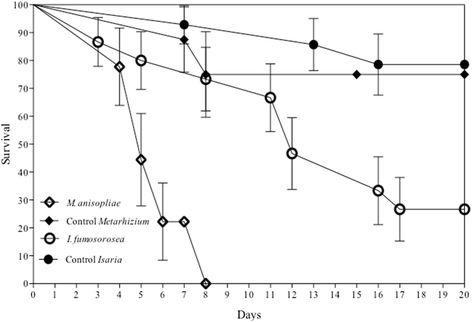
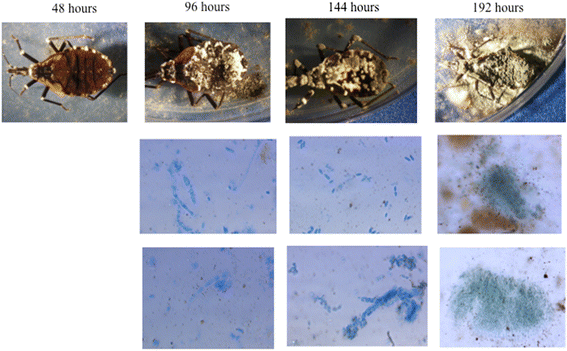
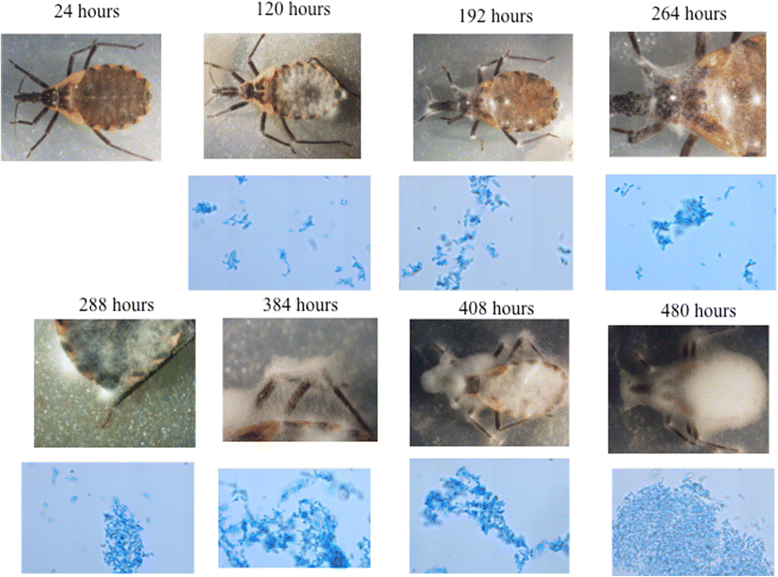
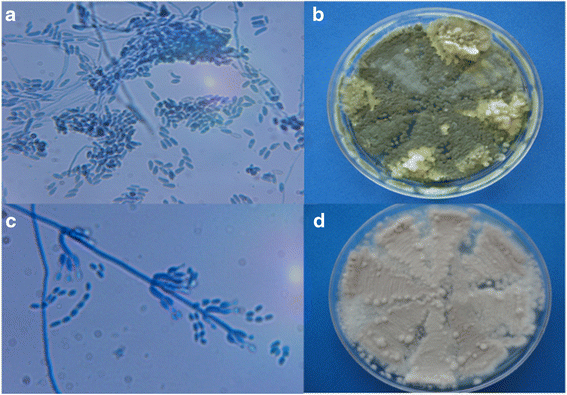
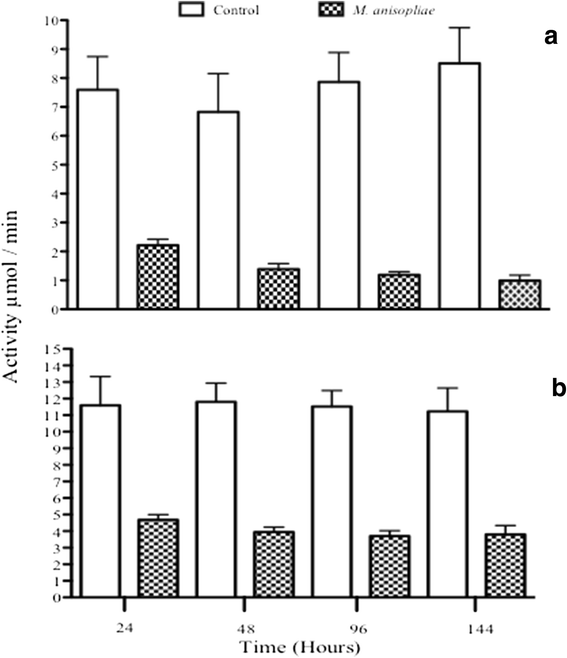

Similar articles
-
Effects of Trypanosoma cruzi on the phenoloxidase and prophenoloxidase activity in the vector Meccus pallidipennis (Hemiptera: Reduviidae).Parasit Vectors. 2018 Jul 27;11(1):434. doi: 10.1186/s13071-018-3016-0. Parasit Vectors. 2018. PMID: 30053904 Free PMC article.
-
Coinfection by Trypanosoma cruzi and a fungal pathogen increases survival of Chagasic bugs: advice against a fungal control strategy.Bull Entomol Res. 2020 Jun;110(3):363-369. doi: 10.1017/S0007485319000713. Epub 2019 Nov 6. Bull Entomol Res. 2020. PMID: 31690355
-
Effects on Meccus pallidipennis (Hemiptera: Reduviidae) Eggs Exposed to Entomopathogenic Fungi: Exploring Alternatives to Control Chagas Disease.J Med Entomol. 2019 Jan 8;56(1):284-290. doi: 10.1093/jme/tjy186. J Med Entomol. 2019. PMID: 30346556
-
Immune defence mechanisms of triatomines against bacteria, viruses, fungi and parasites.Bull Entomol Res. 2015 Oct;105(5):523-32. doi: 10.1017/S0007485315000504. Epub 2015 Jun 17. Bull Entomol Res. 2015. PMID: 26082354 Review.
-
Metarhizium anisopliae enzymes and toxins.Toxicon. 2010 Dec 15;56(7):1267-74. doi: 10.1016/j.toxicon.2010.03.008. Epub 2010 Mar 16. Toxicon. 2010. PMID: 20298710 Review.
Cited by
-
Effects of Trypanosoma cruzi on the phenoloxidase and prophenoloxidase activity in the vector Meccus pallidipennis (Hemiptera: Reduviidae).Parasit Vectors. 2018 Jul 27;11(1):434. doi: 10.1186/s13071-018-3016-0. Parasit Vectors. 2018. PMID: 30053904 Free PMC article.
-
Infection of the Stable Fly, Stomoxys calcitrans, L. 1758 (Diptera: Muscidae) by the Entomopathogenic Fungi Metarhizium anisopliae (Hypocreales: Clavicipitaceae) Negatively Affects Its Survival, Feeding Propensity, Fecundity, Fertility, and Fitness Parameters.Front Fungal Biol. 2021 Feb 24;2:637817. doi: 10.3389/ffunb.2021.637817. eCollection 2021. Front Fungal Biol. 2021. PMID: 37744116 Free PMC article.
-
Trends in taxonomy of Triatomini (Hemiptera, Reduviidae, Triatominae): reproductive compatibility reinforces the synonymization of Meccus Stål, 1859 with Triatoma Laporte, 1832.Parasit Vectors. 2021 Jun 26;14(1):340. doi: 10.1186/s13071-021-04847-7. Parasit Vectors. 2021. PMID: 34174967 Free PMC article.
-
The cost of being a killer's accomplice: Trypanosoma cruzi impairs the fitness of kissing bugs.Parasitol Res. 2019 Sep;118(9):2523-2529. doi: 10.1007/s00436-019-06413-8. Epub 2019 Aug 5. Parasitol Res. 2019. PMID: 31385028
-
Evaluation of the Potential of Fungal Biopesticides for the Biological Control of the Seed Bug, Elasmolomus pallens (Dallas) (Hemiptera: Rhyparochromidae).Insects. 2020 May 1;11(5):277. doi: 10.3390/insects11050277. Insects. 2020. PMID: 32370090 Free PMC article.
References
-
- Carcavallo RU, Galíndez-Girón I, Jurberg J, Galvao C, Lent H. Bibiographic checklist of the American triatominae (Hemiptera: Reduviidae) In: Carcavallo R, Galíndez-Girón I, Jurberg J, Lent H, editors. Atlas of Chagas Disease Vectors in the Americas, Vol. I. Rio de Janeiro: Editora Fiocruz; 1997. pp. 15–52.
-
- Salazar-Schettino PM, Rojas-Wastavino E, Cabrera–Bravo M, Bucio-Torres M, Martínez-Ibarra JA, Monroy-Escobar MC, Rodas-Retana A, Guevara-Gómez Y, Vences-Blanco MO, Ruíz-Hernández AL, Torres-Gutiérrez E. A revision of thirteen species of Triatominae (Hemiptera: Reduviidae) vectors of Chagas disease in Mexico. J Selva Andina Res Society. 2010;1:57–80.
Publication types
MeSH terms
LinkOut - more resources
Full Text Sources
Other Literature Sources

